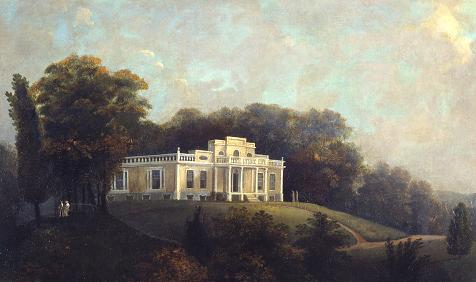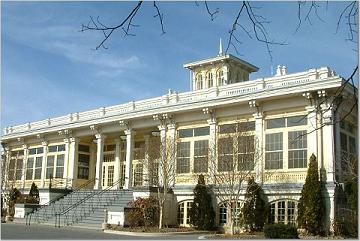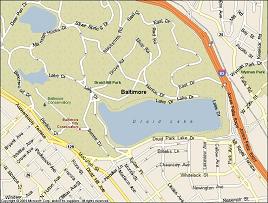 |
| Reception Information |
| |
|
Place : Mansion
House at Druid Hill Park
Date :
April 26, 2008
Time : 5:30pm -
9:30pm
|
 |
 |
| Mansion House in 1811 |
Mansion House Today
| |
| |
The Mansion House as Estate
The present Mansion House, built in 1801, is the
third home built on the estate that has been known
as Druid Hill since the early 1800s. The second
home, designed and built by Colonel Nicholas Rogers
(1753-1822) in the late 1700s, was destroyed by fire
in 1796. Two wings, planned for either side of the
current Mansion House, were never built. The kitchen
was in the basement. The first floor consisted of a
drawing room, salon, and dining room interconnected
along the rear of the house, with a central hallway
dividing the master bedroom and study. Five other
bedrooms were on the second floor.
The Creation of Druid Hill Park
By the mid-1800s, Baltimore was expanding rapidly
and the City sought to purchase the 475-acre Rogers
estate for a park. The Colonel’s son and heir, Lloyd
Rogers, was reluctant to sell. But over his
objections, the Green Spring Avenue Company was
granted a right of way through his property for the
construction of a turnpike. Then, in 1858 Mayor
Thomas Swann created a tax on revenues from new
street car lines to fund the creation of “one or
more large parks.” Two years later, the City paid
Rogers nearly $500,000.
The already well-landscaped estate was enhanced by
engineer Augustus Faul and designer Howard Daniels,
who created “lakes, scenic views, picnic groves,
pathways and promenades.” George A. Frederick
designed several architectural follies that served
as sheltered stops along a small rail line that
wound through the park. The remaining shelters are
among the nation’s oldest park buildings.
The Mansion House as Public Pavilion
Under the direction of John H.B. Latrobe, the
Mansion House was converted into a public pavilion
in 1863. The original entrance was removed and a
20-foot wide open porch was added on all four sides.
The interior was “Victorianized” with Gothic arches,
ornate ceilings, and an elaborate staircase on the
second floor that led to a cupola.
Enclosure of the porch in 1935
prepared it for a brief stint as a restaurant.
“Air-cooled by nature” and billed as “every man’s
country club in the very heart of Baltimore,” it
featured curb service, a modern Milk Bar, a
doughnut-making machine and dining on the veranda.
The building’s cupola beckoned diners upstairs to
observe the city’s tableau.
In the mid-1940s, the building was used as a day
school for the Young Men’s and Women’s Hebrew
Associations, reflecting the growth of the Jewish
population in the Park’s surrounding neighborhoods
since the early 1900s.
The Baltimore Zoo’s Bird House
The Baltimore Zoo,
home to over 2,700 animals including more than 285
mammal, bird, and reptile species, was established
in 1867 adjacent to the Mansion House. Guests
“flocked to what was initially a drive-through
menagerie of 17 species including 215 deer, 15 white
rats, 3 swans, 2 black bears, and 1 three-legged
duck.” When the Hall of Jewels exhibit (featuring
exotic birds and small mammals) opened on the
Mansion House porch in the mid-1950s, the building
was informally dubbed the Bird House and functioned
as such for nearly 30 years.
Restoration Efforts
In 1978, extensive renovations began and bird
exhibit residents were relocated throughout the Zoo.
The building has been used for Zoo administrative
offices and educational programming ever since. A
million-dollar state-funded exterior rehabilitation
began in the summer of 1996. The front entry was
recessed, rotting woodwork and broken windows
replaced, and the porch, along with much of the
first floor, was enhanced by new paint, carpet, and
lighting fixtures.
Sources: Baltimore Zoo; John Dorsey and James D.
Dilts, 1997, A Guide to Baltimore Architecture, 3rd
Ed., Centreville, Tidewater Publishers; Gilbert
Sandler, 2000, Jewish Baltimore, Baltimore, John
Hopkins University Press.
|
|
Directions

(Click For Larger Image)
When planning your trip to the
Mansion House, tools like Google Maps and Mapquest are a
little questionable. Please use your method of
choice to get directions to I-83 from your hotel our
home, and the directions here are spot-on for finding
the Mansion House. From I-83 North or South take
Exit 7 West to Druid Park Lake Drive and stay on right
hand side. Druid Hill Park will be on your right side.
Turn right at the 3rd traffic light (Swan Drive) into
the park. Druid Hill Park’s Lake will be on your right.
Follow to the stop sign ahead and continue on straight
past the stop sign and statue. Take the next left at the
stop sign onto Mansion House Drive. You will see the
Mansion House at the top of the hill. Following the
signs, take the left side of the roadway leading up to
the house. You may park in the lot in front of the
house or in designated parking spots, beside Water Fowl
Lake Pavilion Gate.
|
|
|
| | |